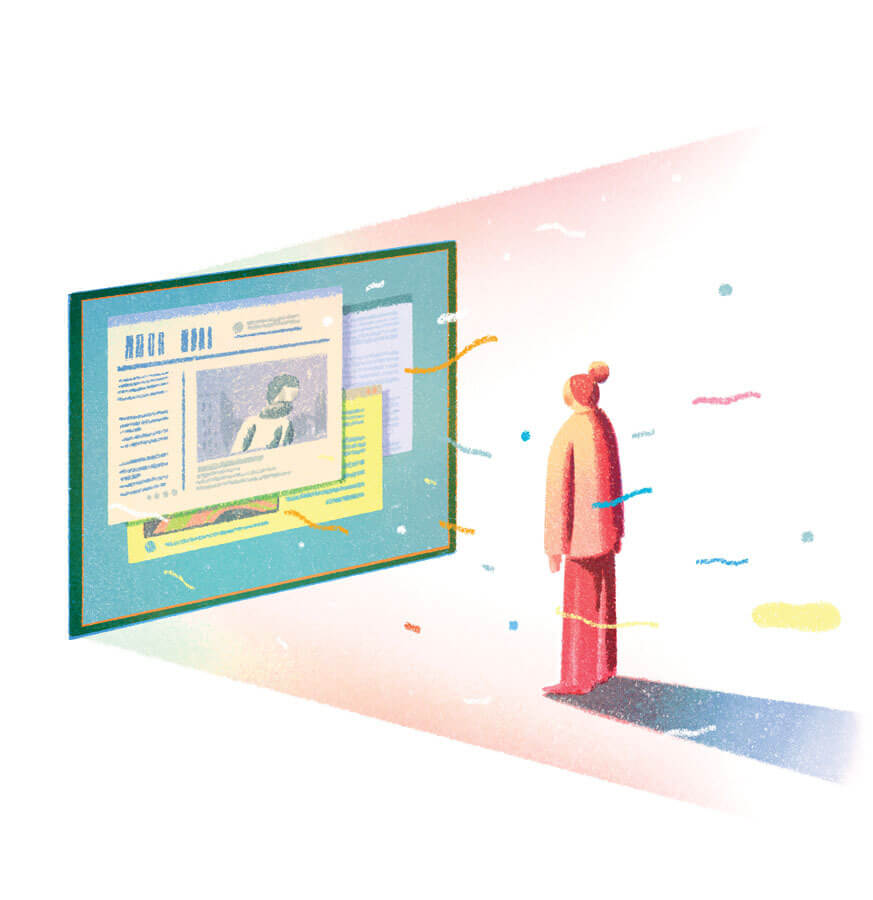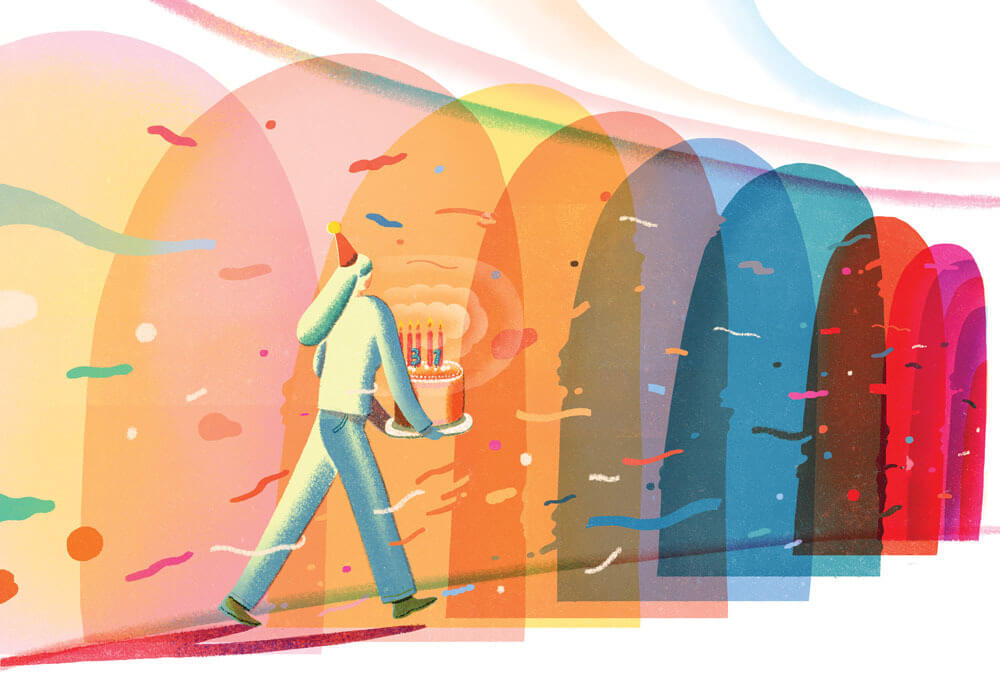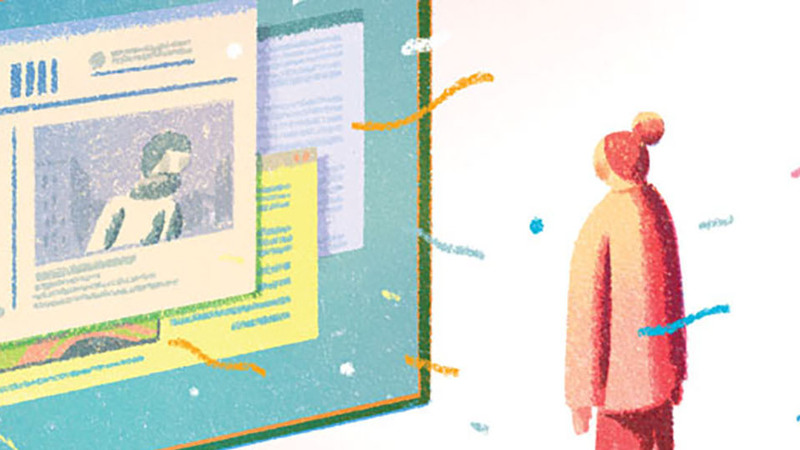At a recent birthday dinner, a friend asked me what she thought was an easy question.
“Now that you’ve finished one decade,” she said — I was turning 31 — “what’s your vision for the next one?”
I paused.
For most of my 20s — perhaps even my teens — I had an answer ready for what I envisioned for my 30s. Your 20s, I always thought, are when you establish your career. Your 30s are when you grow it. So, had someone wanted to know my plans for my fourth decade on Earth, I’d have said simply to build, build, build — in the professional sense. If a house or a husband came along in that span, that would have been fine, too. But for an overachiever like I prided myself on being, professional ambition, not personal growth, was the stuff of long-term goals.
On the cusp of my 30s, though, this question caught me off guard.
The work contract I’d been in for three years was scheduled to end in a few weeks, and I didn’t have a plan for what came after it. The work had been productive: I’d been employed at a major news organization, where, alongside my team, I won the 2021 Pulitzer Prize for public service. It was the exact type of diving board that career growth dreams spring from — but I was no longer certain that that springing was for me.
Like many people in my generation and younger, I have become disillusioned with the idea of work as central to “the good life.” I don’t aspire to leave paid work behind, but, sparked in part by the upheaval of the pandemic, I have begun rejecting the notion that my work is the crux of who I am. I am a journalist, sure, but also a friend, a neighbor and a daughter. Any accounting of what I want out of life needs to consider these identities and countless others, in ways that on my birthday I hadn’t yet sorted through.
I declined, then, to answer my friend’s question, claiming essentially that it was my party and I could refuse to self-interrogate if I wanted to.
But it has been pinging around my head ever since: What does the good life look like — and what exactly does work have to do with it?

As a millennial, I came of age in the “Girlboss” era.
First popularized by a fashion CEO in her 2014 memoir of the same name, a #Girlboss was an executive — or, eventually, any professional woman — who succeeded in business while also being unapologetic about her womanhood. Like the skirtsuit-clad Barbies of our ’90s youth, the Girlboss was upheld as aspirational for women entering the workforce in the 2010s. Girlbossery held that every woman who reached the C-suite was a success story for us all. Infiltrating boys’ clubs, stockpiling wealth and amassing professional achievements were touted as unalloyed goods to millennial women, and in many ways, they were good. The corporate world is famously a white, male space, and reversing that demographic by even a percentage point is a shift in the right direction.
Yet, as the Girlboss sashayed into the halls of power, people began to see she was not always a faultless addition to them. Investigation after investigation revealed that many of the female CEOs the movement exalted were not only “just as successful” as their male predecessors, but just as demanding and abusive, too. Many women reached the top and promptly recreated the sexist, unhealthy conditions they had clawed their way up from — and, by the 2020s, that trend had rendered the Girlboss as outmoded a millennial relic as a black-and-white MySpace selfie.
The internet gave rise to the Girlboss — it was originally a hashtag after all — and today, it is the term’s cultural graveyard. You can still find fresh Girlboss references online, but they’re almost always pejorative. Social media tastemakers are more likely now to skewer the success-obsessed than to praise them, and anti-Girlboss memes are just one tool in their arsenal. From TikToks extolling the leisurely virtues of the fictional Frog and Toad to Twitter threads begging people to “stop glamorizing the grind,” the internet is full of posts that hinge upon a rejection of capitalist work values.
That message is especially popular among Zoomers, the members of Generation Z who were just beginning to enter adulthood when the trend took off. Young people have latched with particular fervor onto the anti-work movement’s punchiest mantra: the short and simple “I do not dream of labor.”
Often deployed with illustrations of what the poster does dream of — sitting in a rocking chair, dancing in a meadow — the statement suggests that “dream job” is an oxymoron. While people might have some jobs they’d enjoy more than others, the idea is that dreams are the domain of pleasure, not business.
Since attribution can be murky online, rumors swirled at first that this statement wasn’t just a social media invention, but a vintage quote pulled from the archives of a labor-conscious intellectual like the late James Baldwin. Evidence suggests that this isn’t true, and the phrase really is a garden-variety internetism. Yet this imagined timelessness points to a larger truth about the new tendency of young people to disdain traditional work: namely, that it isn’t new.
It’s hardly rocket science to note that people have had qualms around hard-driving professionalism for almost as long as there have been professions. The Industrial Revolution had labor organizers, who fought back against grueling work conditions with a demand that each day contain “eight hours for work, eight hours for rest, and eight hours for what you will.” In the middle of the last century, plenty of Gen Z’s own grandparents opted out of the rat race by embracing the counterculture and building anti-capitalist communes. The concept of not wanting to work all the time didn’t originate with today’s young people — so why has it captured them so strongly?
I suggest two explanations, and the first, ironically, is the internet.
While the web is a key forum for young people to express their quarrels with modern living, it is also a source of their discontent. Countless books have been written about its deleterious effects, but one of my favorites is How to Do Nothing by the artist and critic Jenny Odell. Subtitled “Resisting the Attention Economy,” the book deals not with social media’s effects on self-esteem or its tendency towards anonymous bullying, but rather its relentless demands on our time.
The internet, Odell explains, is always on. It does not adhere to business hours, and it constantly tempts us to spend more time responding to emails, pursuing side hustles and transforming ourselves into personal brands. She writes: “In a situation where every waking moment has become the time in which we make our living, and when we submit even our leisure for numerical evaluation via likes on Facebook and Instagram . . . time becomes an economic resource that we can no longer justify spending on ‘nothing.’”
This pull to monetize all 24 of our daily hours is exerted on people of all ages. But having hardly known a world without it, 20- and 30-somethings are uniquely susceptible to its ill effects. The oldest members of Gen Z were in first grade when Facebook was invented. If you had been online for your entire life, wouldn’t you, too, want to log off — not just from social media, but from everything?
I believe that the internet, despite its age-agnostic impact, is a key reason why an anti-work ethos has developed among young people, who have lived online almost since birth.
My other explanation is the pandemic.
I can’t see myself returning to a lifestyle focused on professional achievements at whatever cost they extract from the rest of my life. I’ve seen a world where my work fits into my life instead of my life squeezing in around my work, and I don’t think I can unsee it.
One of my favorite jokes from one of my favorite TV shows, Arrested Development, goes as follows.
The character Tobias, in a self-described “rough patch” with his wife, is asked when his relationship troubles began.
“Well,” he replies, “I don’t want to blame it all on 9/11, but it certainly didn’t help.”
The joke is initially funny because it’s so unexpected — you don’t look for someone who lives nowhere near, and was in no way directly affected by, history’s most horrific terror attack to ascribe his marital problems to it. But it stays funny because there’s a grain of truth to it. Our personal problems weren’t helped by 9/11 shaking up everyone’s lives — and they weren’t helped by COVID-19, either.
Now, I want to be clear: I do not claim that only young people were affected by the pandemic. Having worked as a virus data tracker for three years, I know that the upheavals and sorrows of the COVID era reached us all. (And, of course, it’s worth noting that the virus’ gravest effects — death and severe illness — were borne disproportionately by the oldest among us, not the young and healthy Gen Z.) But I do believe the pandemic shook up the lives of young people in ways that are especially profound.
Think back, as unpleasant as that is, to the earliest months of the pandemic. Recall how your life changed in 2020: how you abandoned your office, lost the ability to dine out and canceled long-cherished plans to go on vacation or see far-off friends. It was a difficult time, right?
Now imagine — or, for parents and young readers, remember — what that time was like for students. As necessary as they were, the closures and Zoom-tinged transformations of schools and colleges during lockdown robbed millions of students of some of their most formative experiences. Did you study abroad when you were in college? Did you go to prom? Many recent graduates never had the chance. For them, instructional hours were canceled, the tenuous social bonds of early college were snapped, and job and internship options disappeared in puffs of virus-laden smoke.
I don’t contend that these losses were worse than the rest of society’s. But, where many older adults experienced the pandemic as a pause in an established life, young people faced it at a moment when their lives were already in transition — from adolescence to adulthood, from student to employee. As such, I believe they were more primed for the changes of the past few years to stick.
That’s certainly what happened to me.
When the coronavirus emerged, I was halfway through a one-year graduate program. I was studying magazine journalism and intending to pursue lifestyle writing jobs that summer. Instead, lifestyle jobs disappeared, and a national newspaper recruited me to join the research team for its coronavirus data project.
Like thousands of other students who graduated into a pandemic-rattled job market, this pivot away from my original goals forced me to reevaluate whether they were still what I wanted. In my case, the answer was yes — despite the years of practice I’ve now had at data journalism, my personality is better suited to lifestyle fare, and I harbor hopes of getting back to it. At the same time, I enjoyed the work I did in hard news. My pandemic-inspired detour into a field I hadn’t considered showed me that I could be happy even in jobs that seem a mismatch for my interests — especially if those jobs give me the freedom to pursue my interests outside of working hours.
Before 2020, I saw no appeal in working remotely. I liked to spend my days busily perched inside a cubicle, working hard and, at many points, working multiple jobs. As a graduate student, I imagined I would return to that professional mode after school ended and stay in it until I retired.
The pandemic, though, showed me another way. With my department working from home and our work subject to strict eight-hour shifts, I found myself, as a COVID tracker, working hard during business hours but flooded with free time outside them. Suddenly, I had no two-hour commute and no need to spend my mornings preparing lunch and picking out professional attire. I had my “eight hours for what you will” back, and I filled them, with puzzles, baking, reading, painting and more.
Many people, of course — frontline workers, parents of homeschoolers, those who were caregivers or were fighting illness themselves — did not have such luxuries. And certainly I want to avoid any suggestion that the pandemic was some sort of net good because it shifted our priorities.
Yet it did cause shifts, and for me, I believe they will be permanent. I may go back to an office one day, at least for part of the week. But I can’t see myself returning to a lifestyle focused on professional achievements at whatever cost they extract from the rest of my life. I’ve seen a world where my work fits into my life instead of my life squeezing in around my work, and I don’t think I can unsee it.
Zoomers and millennials like me are hardly the only people to have emerged from the pandemic with revelations about their lifestyle. There are Baby Boomers who decided to retire early and Gen Xers who traded city-center apartments for suburban houses with yards. But on a generational level, my age-mates are more able to act on these revelations because of our youth and flexibility. If a young person — a 31-year-old millennial, let’s say — wants to leave a job that no longer serves them, they probably have no pension plan, no mortgage payment and, in many cases, no childcare needs holding them back. If they want to find something better, at this stage in their career, they can just do it.
In my opinion, the proliferation of anti-work sentiment among young people online is proof that these two generations are doing exactly that. Because let us not forget: Despite the much-ballyhooed “great resignation,” unemployment is at less than 4 percent, and it’s been there for more than a year. Those who claim that they do not dream of labor aren’t leaving their jobs never to work again — they’re just leaving them for jobs that make them happier.

At my birthday dinner, the one thing I could tell my friend was that last year was the happiest of my life.
It wasn’t because of my professional achievements or some extraordinary personal milestone. Rather, last year was great because I spent a lot of it doing the things I love. I read one book every week. I baked my first cake. I took vacations.
As my work contract neared its end, I still had not figured out what I’d be doing next. Rattled by that uncertainty, I couldn’t, on the spot, come up with a vision for the next 10 years of my life.
After some time to reflect, though, I think I’ve figured it out.
I hope to find another job somewhere — one of the thousands that could make me happy — and I’m confident that, eventually, I will. With the rest of my time, I just want to enjoy things. To read more romance novels and make more buttercream. I’d like to find an apartment where I can paint my walls; I’d love to see the Holy Land; I want to host more parties. I hope to mostly be the opposite of a Girlboss.
I may not be dreaming of labor, but I am dreaming. And I can’t wait to see which ones come true.
Sarah Cahalan is a former associate editor of this magazine. She lives in Chicago with a tall stack of books she wants to read and a full cabinet of baking supplies.
